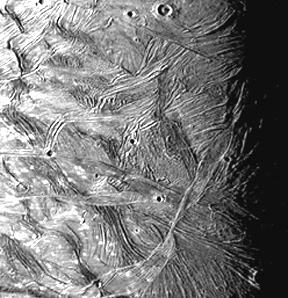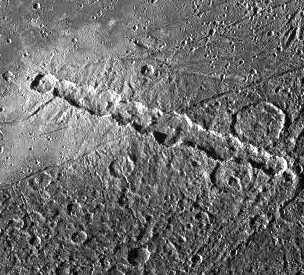Ganymede, while larger than our
Moon, has a similar
appearance - bright and dark areas. The dark areas
are older, heavier cratered while the bright areas
are newer with fewer craters. However, the surface
of Ganymede is comprised of icy rock.Ganymede is
5,262 km in diameter - the largest moon in our Solar
System - and is 1,070,000 km away from Jupiter.
As seen earlier, the physiology of Ganymede is
very similar to
Europa with the exception of the
crust. A liquid ocean may lie underneath as evidence
of geologic activity on the surface:

these stress fractures are the result of possibly
water trying to push upward while Jupiter and the
other three main moons apply their gravity.

The image above also demonstrates the same patterns
- notice the impact craters. Other interesting
features of Ganymede are a result of outside forces:
an impact of what might be a broken object similar
to the impact of comet
Shoemaker-Levy on Jupiter.

Other surprises include a very strong magnetic field
discovered by the
Galileo probes, with what might be
its own magnetosphere. The core also contains
metallic rock similar to
Europa, and a liquid ocean
could enhance the magnetic field.
Another surprise, Ganymede does have a very tenuous
atmosphere comprised of oxygen and ozone.
Back to Top |

